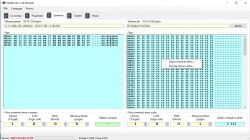I tried to compare the Lens-Men programmer and my NANDLite.
The conclusions are as follows:
NANDProger:
- no support for "4 die" memories, i.e. those with 4 control signals, up to four separate memories in one housing
- transmission speed according to the movie ~ 14MB / s, it's already fun to read
- scans damaged blocks very quickly, 7 seconds all blocks, so it only reads appropriate bytes in the SpareArea area according to the layout documentation
- according to the video, I noticed quite an important element of this programmer, consisting in the fact that it is not possible to program the NAND memory, read yes, but not write it, it is interesting
- the program to operate the programmer so far very poor, you can not see clearly what systems it supports, but maybe the definitions of these systems are somewhere in the text file
NANDLite:
- supports "4 die" memories, it is very difficult to find such memories, but when using the TSOP48 adapter -> LGA52, "4 die" memories are often found
- for me it is still 750kB / s, maybe it will change soon
- I also have to do it at home to make this function available, currently I delete blocks and see which has not been deleted correctly, not in accordance with the specification, I will soon change and add to the Scan Memory button - this is why this function is prepared, currently inactive.
- I do not have this problem, the programmer does much more than is traditionally expected of him, namely, it examines full status readings, records time statistics, etc.
- my application will be developed soon, let me just dig myself out of the current classes
Moreover, have you noticed that:
- the signature of the Samsung K9GAG08U0E chip is not read correctly? Maybe not, but as I have spent more than a year with these memories, I know the signature of this system by heart, it is shown in the film: EC D5 84 72 E0 E0, and in my case it looks like this: EC D5 84 72 50 42 EC D5, and in the documentation says that the signature is: EC D5 84 72 50 42. I did some standardization of the signatures of the circuits, so all of them are 8 bytes. However, manufacturers give signatures from 2 to 8 bytes. The manufacturer shows that it has 6 bytes, I read the next two bytes and I have 8 bytes. Most of the memory rereads the signature, so the bytes are repeating, but for example the Toshiba has encoded additional info not found in the documentation, where this data sometimes changes. So, reading the Toshiba Memory IDs 2x in a row, we have two different signatures. However, the changes are small, usually 1-2 bits, so sometimes one chip comes under two, you need signatures.
- the number of memory blocks shown in NANDProger is 2048, where in fact this memory has 2076 blocks, but the biggest players also had a problem with that
- erases memory quickly, probably too fast. In total, to delete 2048 blocks according to the documentation, we need 1.5ms / block = 3 seconds, here it does in a second, but probably somewhere there is a measurement error or time, or it does not delete at all, that's why it takes so fast.
- and at the end the LEDs are off, hmm ... but it's probably a small nuance, but how they should be, so I can assume that this threshold is not connected to the computer at all.
To sum up, the guys must have rushed to brag about the programmer, because you can see big gaps (not to mention the PCB design, but probably every constructor will find some oversight, carelessness in another PCB designer), but let them try nonetheless.
For my part, I am glad that an alternative is being created, because it enhances the design process, more people are sitting on it, there is competition, even more so, motivation, and the result of all these activities is a new better programmer, i.e. a tool that we are all waiting for.


